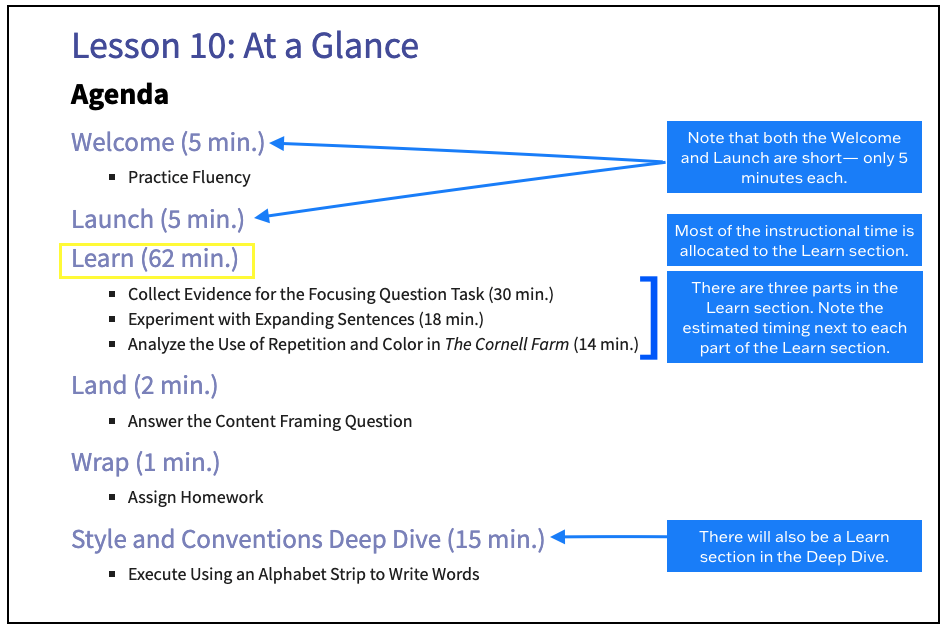Posted in: Aha! Blog > Wit & Wisdom Blog > Implementation Support > Coaching Classroom Educators: Maximizing Instructional Time with Wit & Wisdom®
Our focus this month is on maximizing instructional time. In this leadership blog post, Andrea Baldwin shares a process that Wit & Wisdom implementation leaders use to support school and district leaders in coaching classroom educators.
Time: A Critical Resource
My role as an implementation leader is to collaborate with leaders and coaches who use Wit & Wisdom. We dive deep into the curriculum together, think through implementation challenges, and celebrate the accomplishments of both teachers and students. Educators find pacing lessons to be one of their biggest challenges when implementing Wit & Wisdom—I receive more questions about pacing than almost any other topic! Time is precious, and we all want to make the most of the limited time we have with our students. While pacing problems all have the same result—impeding progress—they have many different root causes. In this blog post, I’ll guide you through a process to uncover some of the most likely contributors to pacing problems.
Step 1: Set a Goal
It takes time to improve pacing, but coaching practices that include goal setting and preparation, analysis, and reflection can help educators identify the root causes of pacing challenges and potential solutions to keeping pace. Begin by identifying the pacing goal. Some examples of goals are, “Complete all four modules in the year,” or “Teach at least 4 full lessons a week.”
Step 2: Plan for Preparation
Wit & Wisdom lessons are rich and filled with opportunities to build knowledge. It takes time to learn the Wit & Wisdom curriculum. If teachers don’t prioritize internalizing the lessons, arcs, and modules, lessons are likely to last longer than the allotted 90 minutes. When pacing questions arise, I spend time with school leaders reflecting on and answering these questions:
- Do teachers’ schedules allow for adequate preparation time?
- How often is preparation time interrupted?
- Do teachers plan with one another to receive maximum support?
- Is a coach available to lead the preparation efforts?
- Have opportunities to learn how to use the preparation protocols been provided to teachers?
Allocating time for preparation and determining structures for collaborative planning are decisions within the leader’s realm of influence. Supporting teachers as learners by prioritizing their preparation has a positive effect on how efficiently they use instructional time.
Preparation time enables teachers to understand the curriculum more deeply. Yet even with thoughtful preparation, teachers must often make on-the-spot decisions about pacing when teaching each lesson. This year, several coaches I work with have used the instructional videos in Wit & Wisdom in Sync™ to support teachers with pacing and instructional decision-making. Before teaching the lesson, some teachers watch the videos to better understand the pace, transitions between tasks, and student work. Other teachers find that coteaching with the Great Minds teacher in the videos significantly improves pacing.
Step 3: Observe Instruction
Cycles of observation and feedback are critical tools to strengthen teachers’ real-time decision-making about pacing. Teachers can markedly improve their skills in handling implementation challenges, such as pacing, when they have a trusted coach in their corner.1
When leaders observe a lesson through the lens of maximizing instructional time, it’s important to ask, “How is time spent in lessons now?” Observing classroom instruction and collecting evidence can answer this question. When observing lessons alongside leaders and coaches, aim to collect concrete and specific evidence. When pacing challenges arise, time stamp lessons by noting how long each section takes. In addition, consider the questions teachers ask, the answers students provide, the directions the teachers give, and the kinds of tasks students complete in the classroom.
Step 4: Reflect and Analyze
After an observation, reflection and analysis take place. Because reflection is inquiry driven, this step can be messy! Keep an open stance here, asking questions to better understand the evidence collected during an observation. Here are three questions to use to reflect on pacing.
1. How did the pacing align with the Teacher Edition lesson timing guidance?
In the Teacher Edition, each lesson’s At a Glance section provides pacing guidance for each lesson component. Review the example below.
 In the above Kindergarten lesson, the Learn section comprises 62 of the 90 minutes planned for instruction. Students work toward two of the three lesson learning goals in this section, and the Check for Understanding occurs during this time. Students meet the third learning goal during the Deep Dive.
In the above Kindergarten lesson, the Learn section comprises 62 of the 90 minutes planned for instruction. Students work toward two of the three lesson learning goals in this section, and the Check for Understanding occurs during this time. Students meet the third learning goal during the Deep Dive.
Teachers should aim to spend most of their time in the Learn section—the heart of the lesson. The Welcome and Launch sections prepare students for the deep learning in the Learn section. Review observational evidence when the Welcome and Launch sections go beyond allocated time, and then strategize how to proceed to the Learn section more efficiently.
2. How did the pace of the lesson support student learning and success with the lesson’s Check(s) for Understanding?
Every lesson includes opportunities for students to demonstrate their learning. These daily assessments, known as Checks for Understanding, provide critical opportunities for students to productively struggle with complex texts. Checks for Understanding are also opportunities for teachers to observe what students can do independently or with minimal support. Here is an example of a Check for Understanding in Kindergarten’s Module 2 Lesson 10.
 Teachers must make many decisions to set students up for success with this task. When observing this lesson for pacing, consider collecting evidence of how the teacher reviews the Evidence Organizer, how the teacher uses a process for calling on volunteers, and how the teacher executes guidance from the Teacher Note. While students are working, observe how the teacher monitors students and uses the provided supports, and note any choices that either help or hinder students in staying on task. These decisions affect pacing and how well students reach the learning goal of collecting illustrations and words as evidence for the Focusing Question Task.
Teachers must make many decisions to set students up for success with this task. When observing this lesson for pacing, consider collecting evidence of how the teacher reviews the Evidence Organizer, how the teacher uses a process for calling on volunteers, and how the teacher executes guidance from the Teacher Note. While students are working, observe how the teacher monitors students and uses the provided supports, and note any choices that either help or hinder students in staying on task. These decisions affect pacing and how well students reach the learning goal of collecting illustrations and words as evidence for the Focusing Question Task.
3. How did the pace of the lesson support student engagement?
Nothing is more joyful than watching a classroom of eager students share their evidence in response to a text-dependent question; they all feel they need to say something! But there is simply not enough time to hear from every student. Teachers who allow every student to respond run the risk of losing the thread of the lesson. At the same time, teachers must balance efficiency with inviting various student voices and responses. Reflect on how the teacher navigates the lesson, allowing for diverse input and keeping students energized and engaged in the learning.
Within the lesson guidance, teachers have frequent opportunities to call on volunteers or strategically select students to share responses with the class. Again—preparation is so necessary! We want teachers to think about how they will communicate appropriate participation in the lesson to students.
 It is also worth noting the execution of instructional routines. When students know exactly what to do during a Think–Pair–Share, for example, teachers maximize instructional time by focusing students on the conversation instead of on finding a partner or starting the conversation. During an observation for pacing, note any instructional routines used in the lesson, and collect evidence of students’ engagement.
It is also worth noting the execution of instructional routines. When students know exactly what to do during a Think–Pair–Share, for example, teachers maximize instructional time by focusing students on the conversation instead of on finding a partner or starting the conversation. During an observation for pacing, note any instructional routines used in the lesson, and collect evidence of students’ engagement.
The three reflection questions above can help coaches and leaders focus on the conversation they want to have with a teacher about the pacing choices made during a lesson. Through reflection and analysis, it is possible to uncover the root causes of pacing challenges, discover possible solutions, and take action to improve lesson implementation.
Summary
Engaging in this process of goal setting, preparation, observation, reflection, and analysis can help educators focus their growth on implementation challenges, such as pacing. Keep an open mind about the root causes of pacing challenges, and then take the steps necessary to make changes that benefit student learning.
If your school or district would benefit from Wit & Wisdom coaching, you can learn more about the new professional learning coaching series here.
Submit the Form to Print

Andrea Baldwin
Andrea Baldwin is a Great Minds implementation leader for Humanities. Before serving in this role, Baldwin traveled around the country training teachers to use Wit & Wisdom while also leading the implementation of Wit & Wisdom in her school district. She is from Columbus, Ohio, and has been in education for 23 years. She wore many hats in her previous district: reading specialist, instructional coach, assistant principal, and curriculum coordinator.
Topics: Featured Implementation Support











